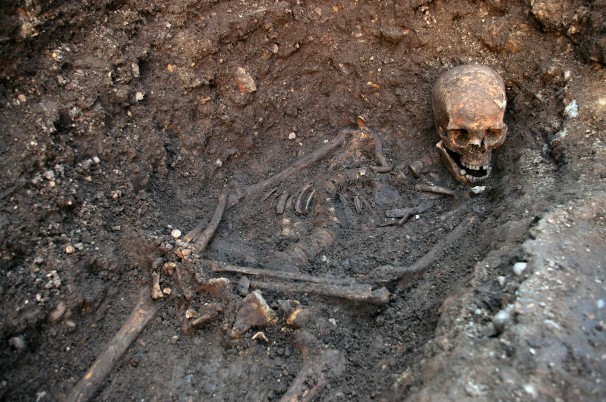Scientists are 99.999 percent sure, in their most conservative estimate, that remains found in 2012 really do belong to King Richard III. These results, published Tuesday in Nature Communications, put a 529-year-old cold case to rest — all thanks to some intense genetic detective work.
The British royal died in battle in 1485. But while he would be immortalized in his namesake Shakespeare play, King Richard III was buried without fanfare. The church that marked his grave had long since been demolished when researchers went looking for it in 2012, and pinpointing its former location took some investigating. But when they finally tracked down Greyfriars Church, its foundation — and by extension, the body of a king — turned out to be under a modern-day parking lot.
Richard III’s skeleton was exhumed soon after and tentatively identified based on its age, battle wounds, and signs of scoliosis — from which the king is believed to have suffered, based on historical descriptions. But to get a more certain identification, researchers needed to look at the skeleton’s DNA. And that’s no easy task.
It makes looking at modern DNA — which comes in long, sturdy strands — seem like a piece of cake. “Ancient DNA is far more difficult to work with,” lead study author Turi King, a geneticist at the University of Leicester, said Monday during a Nature news conference. After death, DNA starts to degrade into smaller and smaller strands.
“If you were to breathe on [Richard III’s] DNA, you’d be depositing huge amounts of your own DNA on it,” King said, and you could completely overwhelm your meager sample. So all analysis had to be done in super-sterile conditions and be repeated in multiple labs to check for accuracy.
King and her colleagues tracked down living relatives of the king and analyzed their genetic makeups, checking up and down the lines of inheritance to see whether the centuries-old skeleton fit into the family tree.
For the most part, the genetic connections were as expected. King and her colleagues did find one break in the chain, but this isn’t surprising: In that many generations, the likelihood of a “false-paternity event” — that is, a child fathered by someone other than the man believed to be the father — is quite high. They can’t be sure at what point in the royal lineage this infidelity took place.
But what if the skeleton belonged to a close relative who died in the same battle? There’s only one cousin for whom this could even be a remote possibility based on historic documents, King and her colleagues report, and the evidence is in the king’s favor.
The combination of circumstances — someone with this particular DNA, who showed signs of scoliosis, and died in battle at the same time and location as the king — means that there’s less than a one in 100,000 chance that the bones belong to someone else.
“The evidence is overwhelming,” King said.
In addition to confirming the king’s identity, the researchers have given the world its first real look at the royal’s features. The earliest portraits of Richard III were painted decades after his death, leaving his true appearance mysterious — until now. We now know that he was almost certainly blue-eyed and that he probably had blond hair as a child (though it may have darkened later). You can see a facial reconstruction based on his skull here.

